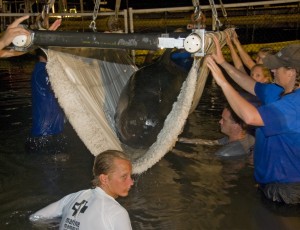Pilot Whale 300 Moves to New Home
 The Marine Mammal Conservancy is proud to announce the relocation of pilot whale 300 to SeaWorld. The first whale rescued during the May 5th, 2011 stranding in Cudjoe Key, FL 300 was the final whale to complete rehabilitation at the Marine Mammal Conservancy. 300 was transported by stretcher into a neutrally buoyant position inside a wet transport module specifically tailored to meet her special needs.
The Marine Mammal Conservancy is proud to announce the relocation of pilot whale 300 to SeaWorld. The first whale rescued during the May 5th, 2011 stranding in Cudjoe Key, FL 300 was the final whale to complete rehabilitation at the Marine Mammal Conservancy. 300 was transported by stretcher into a neutrally buoyant position inside a wet transport module specifically tailored to meet her special needs.
After surviving numerous medical challenges, 300 was deemed non-releasable by the National Marine Fisheries Service (NMFS) based on established guidelines for release and input from independent marine mammal experts. NMFS has placed her in the care of SeaWorld, where she will be reunited with 301, a calf that was rescued during the same stranding event.
The MMC staff would like to thank all of the volunteers, SeaWorld and our stranding network partners who have committed so much time and effort to make this rescue and rehabilitation possible.
Pilot whales Y-400 and Y-404 Location Update (June 29th, 2011)
June 29th, 2011
The whale appears to have found something of interest at depth off the eastern tip of Cuba. Recently, he has begun to increase the number of dives he is making to 600m-900m. Overall, 70% of his dives are less than 50m deep, and about 5% of dives are to 200-400m, with very occasional dives of 1,000m-1,500m. About a third of his dives are of 5 min-15 min duration, with a few dives to >40 min.
June 27th, 2011
The whale continues to move slowly toward Windward Passage, between Cuba and Haiti.
June 19th, 2011
The whale has moved north from Great Inagua and is headed toward Turks and Caicos.
May 22nd, 2011
Y-400 and Y-404 continue to remain together, and are now somewhere off the Blake Plateau (approximately 700 miles east of Charleston South Carolina) which is reasonable habitat for pilot whales. They have been making dives that are mostly less than 50 m deep, but some are to 100-200 m. Most dives are of 5-20 min duration, but occasional dives have been recorded as lasting more than 30 min but less than 40 min.
Fishing Line Takes Tragic Toll on Marine Life
HARBOR BRANCH – FAU RESEARCHERS RESCUE DOLPHIN CALF in the INDIAN RIVER LAGOON
Entanglement from monofilament fishing line takes a tragic toll on all marine life.
21 January 2011, NOAA/NMFS assigned Capture Supervisor Steve McCulloch, Program Manager of Marine Mammal Research at Harbor Branch Oceanographic at FAU (HBOI) assembled and led multi-agency Intervention Team to locate and successfully disentangle a dolphin calf in the Indian River Lagoon (IRL). The mother dolphin (MOMW) has been known to McCulloch and HBOI researchers since 1996, when he helped initiate photo-identification surveys in the IRL. (MONO) is her fourth calf.
“The mom/calf pair have an expansive 30-mile home range within the IRL so we relied on a decade of sighting history data to narrow down the primary search area” explains McCulloch. Still, it took the thirty-member team and six boats, two days to locate the dolphin pair. Once both dolphins were in shallow water and alone, McCulloch initiated the ‘take’, first encircling the dolphins in a 400 yard capture net, and deploying five ‘chase boats’ so that team members could respond immediately to secure and support the calf, while the mom was safely released and waited anxiously nearby. Both dolphins could be heard whistling to one another during the entire process.
